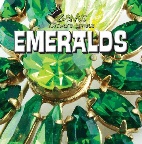-
 Tacos, enchiladas, tortillas, and even huevos rancheros are not unusual items in many American restaurants. Mexican food is loved all over the world, but Mexicos kitchens hold much more than these dishes. Some surprising ingredients and fascinating cultural facts are in store for readers and fledgling chefs. Mexicans use prickly pear cactus, plantains, and even chocolate in their meals. A salsa recipe at the end of the book gives young cooks a chance to create their own fiesta!
Tacos, enchiladas, tortillas, and even huevos rancheros are not unusual items in many American restaurants. Mexican food is loved all over the world, but Mexicos kitchens hold much more than these dishes. Some surprising ingredients and fascinating cultural facts are in store for readers and fledgling chefs. Mexicans use prickly pear cactus, plantains, and even chocolate in their meals. A salsa recipe at the end of the book gives young cooks a chance to create their own fiesta! -
 Emeralds are the most expensive gems in the world, but it takes a lot of time and effort for them to get that way. Readers will discover many interesting facts about this beautiful May birthstone that takes millions of years to form. Vibrant photographs capture emeralds at all stages, from the mines to beautiful pieces of jewelry.
Emeralds are the most expensive gems in the world, but it takes a lot of time and effort for them to get that way. Readers will discover many interesting facts about this beautiful May birthstone that takes millions of years to form. Vibrant photographs capture emeralds at all stages, from the mines to beautiful pieces of jewelry. -
 There are many different types of diamonds in the world. They come in a range of colors and can be cut into all kinds of shapes. This book shows readers that the way these different kinds of diamonds are created really isn't that different at all. Interesting facts and detailed photographs explain where these gems come from, how they're made into jewelry, and what makes them so valuable.
There are many different types of diamonds in the world. They come in a range of colors and can be cut into all kinds of shapes. This book shows readers that the way these different kinds of diamonds are created really isn't that different at all. Interesting facts and detailed photographs explain where these gems come from, how they're made into jewelry, and what makes them so valuable. -
 In 1878 in Denison, Texas, a man named John Martin looked up into the sky and saw something he could not explain. Americans have been hooked on the possibility of beings from space visiting Earth ever since. A sense of wonder, and reality, are brought to some popular legends of alien encounters and sightings in this volume. The final chapter explores how these legends have become even more popular thanks to movies, television, and literature.
In 1878 in Denison, Texas, a man named John Martin looked up into the sky and saw something he could not explain. Americans have been hooked on the possibility of beings from space visiting Earth ever since. A sense of wonder, and reality, are brought to some popular legends of alien encounters and sightings in this volume. The final chapter explores how these legends have become even more popular thanks to movies, television, and literature. -
 Family, friends, and food make Thanksgiving many Americans favorite holiday. This caption book uses accessible bilingual text to explain the holidays beginnings as a Pilgrim feast as well as to present some of todays popular traditions. Colorful photographs encourage readers to learn about the meaning of Thanksgiving and to share some of their favorite parts of the holiday.
Family, friends, and food make Thanksgiving many Americans favorite holiday. This caption book uses accessible bilingual text to explain the holidays beginnings as a Pilgrim feast as well as to present some of todays popular traditions. Colorful photographs encourage readers to learn about the meaning of Thanksgiving and to share some of their favorite parts of the holiday. -
 Veterans Day was established to honor the veterans of World War I. Today, the holiday is used to show gratitude for all people who have served in the military. Easy-to-follow text in English and standard Latin American Spanish explains the history and ceremonies associated with the holiday. Full-color photographs show patriotic ceremonies and parades and will help emerging and bilingual readers appreciate the importance of this holiday.
Veterans Day was established to honor the veterans of World War I. Today, the holiday is used to show gratitude for all people who have served in the military. Easy-to-follow text in English and standard Latin American Spanish explains the history and ceremonies associated with the holiday. Full-color photographs show patriotic ceremonies and parades and will help emerging and bilingual readers appreciate the importance of this holiday. -
 Americas workers are the focus of Labor Day, as this patriotic holiday honors the struggles people faced in the pursuit of fair wages and safe working conditions. Photographs show historical context as well as contemporary celebrations of the holiday. Accessible bilingual English and Spanish text explains the history and traditions associated with this end-of-summer holiday.
Americas workers are the focus of Labor Day, as this patriotic holiday honors the struggles people faced in the pursuit of fair wages and safe working conditions. Photographs show historical context as well as contemporary celebrations of the holiday. Accessible bilingual English and Spanish text explains the history and traditions associated with this end-of-summer holiday. -
 Memorial Day honors those who have died in service to their country. This volume uses easy-to-follow English and standard Latin American Spanish to explain the origins of this special day, as well as the ways in which Americans use the day to take pride in their fallen soldiers. Bright photographs show soldiers, families, and children taking part in parades and other activities that demonstrate respect and gratitude to the people of service
Memorial Day honors those who have died in service to their country. This volume uses easy-to-follow English and standard Latin American Spanish to explain the origins of this special day, as well as the ways in which Americans use the day to take pride in their fallen soldiers. Bright photographs show soldiers, families, and children taking part in parades and other activities that demonstrate respect and gratitude to the people of service -
Sin stock
 Explores the life of the man who made the famous midnight ride during the American Revolution to warn of the impending arrival of British troops.
Explores the life of the man who made the famous midnight ride during the American Revolution to warn of the impending arrival of British troops. -
 Many beagles and other scent-driven canines have been used successfully to sniff out bombs, drugs, and lost people, too. Today they are even used to help the many people who have had to fight the rising problem of bedbug infestation. Age-appropriate bilingual text explores the life, training, and work of these bedbug-sniffing dogs.
Many beagles and other scent-driven canines have been used successfully to sniff out bombs, drugs, and lost people, too. Today they are even used to help the many people who have had to fight the rising problem of bedbug infestation. Age-appropriate bilingual text explores the life, training, and work of these bedbug-sniffing dogs. -
 esde hace más de dos décadas, la Legislación de Derecho Internacional privado trata de paliar la dispersión normativa del sistema de Derecho internacional privado español. Las reglas de producción interna, que se encuentran asimismo dispersas en Códigos, leyes, y reglamentos promulgados por el legislador español, se incluyen en el primer epígrafe de la legislación. No se trata de la parte más extensa, pues los reglamentos europeos y los distintos convenios internacionales que se ordenan en los epígrafes subsiguientes ocupan buena parte del compendio legislativo y su proporción es creciente. A diferencia de otras publicaciones al uso, la Legislación de Derecho internacional privado publicada en la editorial Comares aporta el valor añadido por los cuatro autores, a través, por un lado, de notas a pie de página que incluyen información explicativa, concordancias y referencias, y ayudan a comprender las complejas relaciones entre los distintos cuerpos normativos y normas concretas del Derecho internacional privado español. Se añade a ello un extenso índice analítico, detallado a través de múltiples voces, apartados y subapartados, que orientan al lector en la búsqueda de la reglamentación aplicable en razón de la materia, el texto legal o los países involucrados en una relación privada internacional. Por su parte, la ordenación de los textos facilita el manejo de la obra. En un primer epígrafe se extractan, como se ha dicho, las normas de Derecho internacional privado contenidas en los distintos cuerpos legislativos de producción interna. Un segundo epígrafe recoge, por orden cronológico, las aportaciones cada vez más abundantes del Derecho internacional privado europeo, seguramente el sector más extenso y complejo. Seguidamente, se ordena el Derecho internacional privado convencional, sobre el mismo principio cronológico pero a partir del foro de codificación: Conferencia de La Haya, Consejo de Europa, CIDIP, CIEC, Naciones Unidas . Finalmente, por orden esta vez alfabético del Estado parte extranjero, se relacionan los convenios bilaterales ratificados por España en materia de Derecho internacional privado.
esde hace más de dos décadas, la Legislación de Derecho Internacional privado trata de paliar la dispersión normativa del sistema de Derecho internacional privado español. Las reglas de producción interna, que se encuentran asimismo dispersas en Códigos, leyes, y reglamentos promulgados por el legislador español, se incluyen en el primer epígrafe de la legislación. No se trata de la parte más extensa, pues los reglamentos europeos y los distintos convenios internacionales que se ordenan en los epígrafes subsiguientes ocupan buena parte del compendio legislativo y su proporción es creciente. A diferencia de otras publicaciones al uso, la Legislación de Derecho internacional privado publicada en la editorial Comares aporta el valor añadido por los cuatro autores, a través, por un lado, de notas a pie de página que incluyen información explicativa, concordancias y referencias, y ayudan a comprender las complejas relaciones entre los distintos cuerpos normativos y normas concretas del Derecho internacional privado español. Se añade a ello un extenso índice analítico, detallado a través de múltiples voces, apartados y subapartados, que orientan al lector en la búsqueda de la reglamentación aplicable en razón de la materia, el texto legal o los países involucrados en una relación privada internacional. Por su parte, la ordenación de los textos facilita el manejo de la obra. En un primer epígrafe se extractan, como se ha dicho, las normas de Derecho internacional privado contenidas en los distintos cuerpos legislativos de producción interna. Un segundo epígrafe recoge, por orden cronológico, las aportaciones cada vez más abundantes del Derecho internacional privado europeo, seguramente el sector más extenso y complejo. Seguidamente, se ordena el Derecho internacional privado convencional, sobre el mismo principio cronológico pero a partir del foro de codificación: Conferencia de La Haya, Consejo de Europa, CIDIP, CIEC, Naciones Unidas . Finalmente, por orden esta vez alfabético del Estado parte extranjero, se relacionan los convenios bilaterales ratificados por España en materia de Derecho internacional privado.















